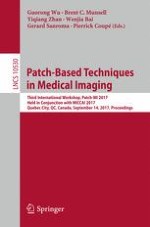2017 | Buch
Patch-Based Techniques in Medical Imaging
Third International Workshop, Patch-MI 2017, Held in Conjunction with MICCAI 2017, Quebec City, QC, Canada, September 14, 2017, Proceedings
herausgegeben von: Guorong Wu, Brent C. Munsell, Yiqiang Zhan, Wenjia Bai, Gerard Sanroma, Pierrick Coupé
Verlag: Springer International Publishing
Buchreihe : Lecture Notes in Computer Science
